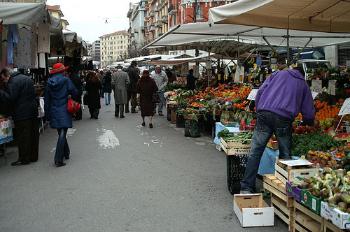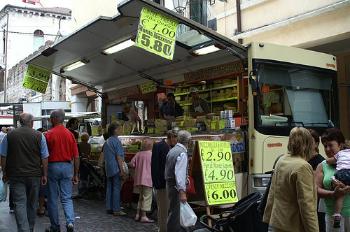Italian Food Markets: Rules, Vocabulary, & Market Days in Italy
 If you’re not a foodie when you get off the plane in Italy, you just might be one by the time you leave. This country can do that to you. But you don’t have to be some kind of expert to thoroughly enjoy all kinds of culinary exploration during your trip – nor do you need to have a big travel budget to get into Italian food. You just need to have a sense of adventure, and you’ll want to seek out the Italian market days.
If you’re not a foodie when you get off the plane in Italy, you just might be one by the time you leave. This country can do that to you. But you don’t have to be some kind of expert to thoroughly enjoy all kinds of culinary exploration during your trip – nor do you need to have a big travel budget to get into Italian food. You just need to have a sense of adventure, and you’ll want to seek out the Italian market days.
While most tourists only happen upon Italian markets by accident as they’re walking from one museum to another, other people treat these markets as attractions all by themselves. They’re colorful and lively, and generally speaking aren’t for the tourists at all. These are where the locals pick up the foodstuffs that stock their pantries every week, and sometimes where they get their cleaning supplies, CDs, kitchen equipment, clothing, pet food, and furniture as well. Depending on the size of the market, you could buy just about everything you’d ever want from a hastily set-up table or from the back of a van that only pulls up once a week.
But while you might not be there to pick up toilet cleaners or coffee pots, anyone can take advantage of the edible items that are always for sale at these markets in Italy. Certainly, part of the fun could be identifying unfamiliar fruits and veggies (not to mention seafood or meat) and then learning their Italian names, but if you’ve got an apartment rental in Italy or you’re staying in a hostel that has a kitchen you can do more than just look at the goodies on sale. You can become an active participant in the age-old tradition of market shopping!
In this article, you’ll find information about how to buy food in Italian markets (there are rules, of course!) and also how to find out when the market days are where you’ll be visiting. Generally speaking, towns will have one day a week when the market comes to town – unless it’s a bigger town or city, in which case there may be several market days in different parts of the city. There are some market vocabulary words listed below that you’ll probably want to learn in order to do business in an Italian food market, and I’ve also found a few easy-to-prepare “hostel recipes,” as I’m calling them, which you should be able to whip up with what you can find on hand in a hostel or apartment rental kitchen. But even if you don’t have a kitchen at your disposal you can still shop in Italian markets – just pick up a hunk or cheese, a loaf of bread, a piece of sausage, some fruit, and a bottle of wine or water and you’ve got the makings of a fine picnic.
Rules of Markets in Italy
- Don’t touch the merchandise!
You don’t get to touch what you’re buying until you’ve paid for it. This may seem counterintuitive, because, you’re thinking, “How can I tell if that peach is good if I don’t pick it up?” But in Italian markets, unless you’ve been given permission to serve yourself by the vendor, you’ll tell them what you want and how much of it you want and they’ll get it for you. The assumptions are that everything they have is good (so you don’t need to worry about getting anything bad), they know their inventory better than you do, and they don’t know where your hands have been. So this practice is partly bowing to their superior knowledge and partly about hygiene. In my experience, it’s more of the former than the latter, because I’ve even heard that regulars get better pickings than newcomers, so even if you move to a new neighborhood and aren’t just a tourist you won’t get the best that vendor has to offer until you’ve come back for a few weeks in a row. Be that as it may, regardless of the fairness of this system, it is the way it is – so you’ll need to get used to it. Just point to what you want if you don’t know the word, tell the vendor how much you want (weight or number), and add a nice “per favore” at the end. They’ll usually choose and bag it for you, or hand you a bag and gesture that you can do it yourself (if you’re allowed to do it yourself, be careful not to rifle through everything – this is where the hygiene thing comes in). Oh, and this rule applies to all foodstuffs; if you’re buying CDs or sponges, you can pick those up and look at them before you’ve paid for them! - Bring your own bag.
The Italians shop with their own bags, whether they’re plastic bags they’ve gotten at the store in the past or cloth bags specifically meant for market days. In Italian supermarkets, you’ll most likely pay a few cents for a plastic bag if you don’t already have one, so the locals have gotten used to bringing their own bags. You probably aren’t shopping with your own grocery bags, but a daypack/backpack will probably do just fine. The individual plastic or paper bags the vendor puts your fruits, veggies, or cheeses in doesn’t cost you extra, so don’t worry about that. - Don’t try to barter.
Haggling may be considered a sport by some people, but unless you know the vendor you’re not likely to get a discount on your purchases. In fact, you’re likely to insult them by offering less than the posted price. You can try to barter with the folks selling clothing if you’d like, but when it comes to the food vendors you’ll be paying the price that’s listed. They may choose to round your final price if you’ve bought a few things, but that’s their decision to make – not yours. - Look for the lines.
It’s true the world over, and it’s true in Italy – if there are five vendors selling the same thing and only one of them has a long line, it’s because that’s where the best stuff is. If you’ve got the patience and are keen on getting the best the market has to offer, hop in that line and just buy what everyone else is buying. Because while that vendor may have the best beans, the one down the block might have better tomatoes. - Know what you can bring home.
You may have decided that rather than buy Italian goodies to cook while you’re in Italy you’ll bring them home as the perfect souvenir. Many of the things you find in Italian food markets is perfectly acceptable to bring back with you – but some of it isn’t. You can bring home dried foods, even dried mushrooms, and cured cheeses (like parmigiano) so long as they’re vacuum-packed. You can even bring back roasted coffee, but don’t even think about packing meats of any kind – even if it’s fully cured, and even if it’s vacuum-packed. It’ll get taken away at customs faster than you can say, “Mamma mia!”


Italian Market Vocabulary
Italy is on the metric system, so not only are you dealing with a foreign language, you’re also dealing with kilograms instead of pounds. If you’re just cooking a small amount, you can sometimes ask for a number of things instead of a weight (4 tomatoes, for instance), but to really act like you know what you’re doing you can try on these words for size.
- etto (ETT|toh)- 10th of a kilogram (plural is etti, or ETT|tee)
- chilo (KEE|loh)- one kilogram (just over 2 pounds)
- per oggi (pehr AWJ|jee) – “for today,” if you’re buying fruit that you’d like to be able to eat right away rather than let it ripen
- commas instead of periods – Note that Italian prices are written with the commas and periods swapped from the way we list them. So instead of €3.50 it would be written €3,50 – and if you were buying truffles and the number got high enough, you could fork over more than €1.000 rather than €1,000.
- numbers – It’s a good idea to learn your numbers 1-10, and then 100 and 1000 (though those last two are less likely to be useful when you’re buying food!). In Italian, 1-10 are: uno (OO|noh), due (DOO|eh), tre (treh), quattro (QWAH|troh), cinque (CHEEN|kweh), sei (say), sette (SEHT|teh), otto (AWT|toh), nove (NOH|veh), dieci (dee|EH|chee).
This video from the Cross-Pollinate family demonstrates that even the kids can go market shopping in Italy.
Food shopping tips in Italy from Cross-Pollinate Travel on Vimeo.
Market Days in Italy
While these links will help you find some of the markets in Italy, they aren’t comprehensive. So it’s a good idea to stop by the local tourist information office and see when the local market days are (and if there are multiple ones for a larger town or city).
- Moving2Italy2 has a great collection of links with information about market days all over Italy, broken down by region, and including antique markets.
- Tuscany Net has links to the market days in the major cities in Tuscany.
- In Italy has some of the outdoor food & antique markets listed by region; but remember that not all of the Italian food markets are outdoors!

“Hostel Recipes”
- SlowTravel has a couple of links to “vacation rental recipes” by Judith Greenwood, which are specifically for Italian cooking.
- For general tips, here’s a great primer about how to make a hostel dinner – including a couple recipes at the bottom (not all Italian, but all tasty!).
all photos by Jessica Spiegel & may not be used without permission